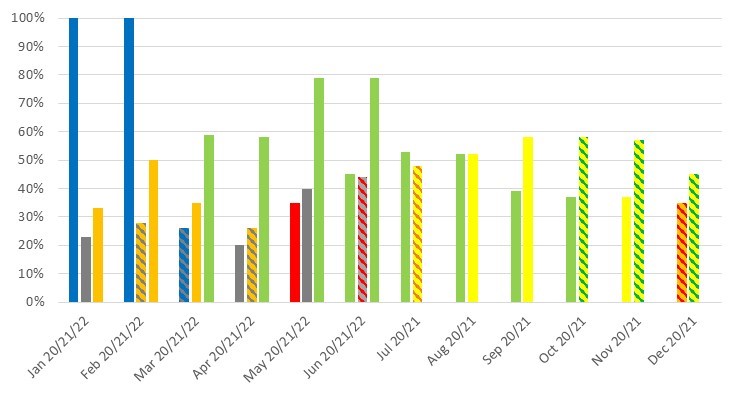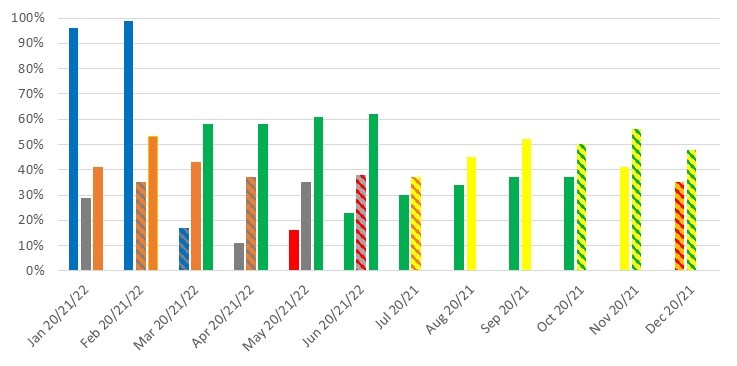Staff Report #4
June 29, 2022
To All Commissioners
Re: COVID-19 Ridership and Service Impacts
Recommendation
The report be NOTED and FILED.
Background
The pandemic declaration in March of 2020 and associated lockdown measures that have followed have resulted in declines in transit ridership on both the conventional and specialized services. Each new wave of the pandemic has resulted in varying levels of public health measures, including lockdowns in some cases. In addition to the impacts on ridership, London Transit has experienced numerous other issues that have impacted the ability to deliver service and work program initiatives as planned.
As the remainder of this report will illustrate, London Transit, consistent with transit systems across the country, finds itself if the eye of a perfect storm. While ridership levels are returning with many buses carrying standing loads, employee resource and supply chain issues are limiting the ability to increase service levels in response. The remainder of the report will discuss each of these elements in greater detail.
Conventional Transit
Ridership
The organizational philosophy adopted at the onset of the pandemic with respect to service levels was to ensure that all areas of the city that were served by transit would continue to be served, albeit at lesser frequencies based on employee resource availability.
The graph below provides an overview of the ridership levels on the conventional service for 2021 and 2022 to date with comparative data for 2020, both as a percentage of what would normally be expected in each month noting the numbers are based on actual boardings as counted by the automatic passenger counters on buses. The bars are coloured to match the various stages of lockdown as noted below:
Green Prevent – no, very limited restrictions in place
Yellow Protect & Stage 3 under the current re-opening plan – very limited restrictions in place
Orange Restrict & Stage 2 under the current re-opening plan – limited restrictions in place
Red Control & Stage 1 under the current re-opening plan – numerous restrictions in place
Grey Lockdown – full lockdown restrictions in place
The colour blue in the graphic is used for January and February 2020 given the pandemic declaration had not occurred at that point in time. Bars that are striped indicate a change during the month from the base colour to the striped colour.
2020, 2021 and 2022 Conventional Transit Weekday Ridership as a Percentage of Normal

The above graph clearly depicts the impacts that the various stages of lockdown have on conventional transit service ridership. As indicated in the graph, weekday ridership in June has held consistent with May levels at approximately 80% of normal. It should be noted that this graph is depicting ridership as a percentage of normal in each month, and ridership numbers for the period of May through August are traditionally lower than the rest of the year given the post-secondary students are not attending school during this period. Of interest, weekend ridership in June continued to surpass pre-pandemic ridership levels for the spring service period, which is problematic given the shortage of resources required to increase service levels.
The next signup period begins June 26, 2022 and runs to September 3, 2022. During this period, typical summer level of service will be in place with the exception of Express Routes (90, 91, 92 & 94) which will not operate. Onboarding of new Operators will continue through this period which may allow for the use of tripper buses on routes experiencing overcrowding or schedule adherence issues due to construction related detours. At this time, it is anticipated that Express Routes will recommence operation with the September signup beginning September 3, 2022. Administration will be closely monitoring complement levels over the coming weeks and months, and will continue to enhance service levels as complement is available.
Employee Resource Requirements – Operations
Work continues with respect to the onboarding of Operators with a class of seven recently completing training and a new class of six which began training on June 13, 2022. It is anticipated that classes of six will continue to run throughout the summer in an effort to attain a higher complement level which will support service level increases being implemented through the fall.
Employee Resource Requirements – Fleet and Facilities
There are currently two skilled labour positions and two general service positions open and posted. There are currently no applicants for the skilled labour positions, and administration is in the process of reviewing applicants for the general service positions. In addition to the vacancies resulting from retirement, a number of employees in this department are also off work longer than what would be considered normal, primarily as the result of delays relating to the pandemic.
Administration has been addressing these shortfalls through moving people between the Highbury and Wonderland facilities, moving tasks between shifts, and offering overtime. While these approaches have had success thus far, the appetite for overtime will decline over the summer months as this is prime vacation time. Should these complement levels not be addressed through recruitment in the coming months the ability to ensure the required number of buses each day for service may be impacted.
Supply Chain Issues
Over the past number of months, supply chain issues have, to varying extents, impacted the ability to service and maintain the conventional fleet.
There has been some progress on previously reported issues, most notably, the issue of availability of transmission fluid for buses has been addressed and is no longer a concern, and the replacement bus engines that were ordered in August 2021 have begun to arrive. This will allow work to begin on engine replacements, which will result in additional buses being available for service.
In late April, New Flyer advised that, due to a global computer chip shortage and the need for same for the Multiplex Module on board the bus, delivery of both the 2022 replacement and expansion buses is likely to be delayed. The most recent update from New Flyer indicates this shortage is anticipated to be a problem until at least August, and that the 22 buses on order (17 replacement and five expansion) are not expected to be fully delivered until sometime in 2023. This could result in additional and unbudgeted costs to repair buses that are currently parked and scheduled for retirement. Delay of the delivery of the five expansion buses will have a greater impact on service, as it will limit the ability to implement the 2022 service improvements until such time as the buses have been received and prepped for service.
With the onset of the hot weather in early June, a new problem affecting a specific series of bus (DL40) of which there are 32 remaining in the fleet has been identified. These are the oldest buses in the fleet and are subject to higher instances of failure, specifically, the condensers for the HVAC units on the buses are failing and parts supply is a challenge given the age of the units. The increased pollen in the air is resulting in the filters clogging, which places greater pressure on the condensers, which in turn are failing. Additionally, passengers are opening windows on extremely hot days, which force the units to run more in an effort to maintain temperature control inside the bus. Once this occurs, the bus cannot continue in service on days of extreme weather conditions given the lack of climate control. In an effort to mitigate these issues, the filters are being cleaned on a more regular basis, and this series of bus is being placed on shorter runs or not being used on extremely hot days when possible.
Finally, there are currently three hoists at the Highbury facility that are out of service and cannot be rebuilt until parts are available. Once the parts arrive the work can be scheduled. Staff have worked to schedule bus servicing and maintenance around this issue, and thus far, bus availability servicing has not been negatively impacted; however this may become more problematic as the fall approaches given the anticipated need for more buses for service each day.
Specialized Transit
Ridership
The graph below provides an overview of the ridership levels on the specialized service for 2021 and 2022 to date, with comparative data for 2020 as a percentage of what would normally be expected in each month. Consistent with the earlier graph, the colours in the various bars are reflective of the stages of lockdown that were in place at the time.
2020, 2021 and 2022 Specialized Transit Ridership as a Percent of Normal

As the graph indicates, ridership levels to date for March through June 2022 surpassed the previous pandemic-period high from November 2021. Administration will continue to monitor trip demand by time of day and day of week, and gradually increase service hours to meet demand.
Service
As indicated above, administration is continuing to monitor service demand and will work with the contracted service provider to increase service levels as demand warrants. The only issue with respect to making these adjustments relates to the service provider’s ability to secure drivers to meet the increased service requirements.
Corporate Communications
Over the coming months, communication will be paramount in order to ensure that riders have the most up to date and accurate information regarding service, and also have an understanding of the issues being faced and the steps being taken to address them. Should the aforementioned issues result in the need to reduce services or delay service improvements, it will be imperative that all stakeholders understand the reasons behind the decisions as well as the plans to mitigate the issues going forward and communications will be focused on sharing this information.
The corporate website, socials and stop-level notices will continue to be utilized, as appropriate, to provide up to date service information including service interruptions, detours etc. to keep customers informed with respect to current issues and plans going forward.
Internally, information screens will continue to be utilized to ensure that employees are informed of the issues being faced and the plans to address them.
As previously mentioned, with respect to vacancies and ongoing recruitment, in addition to advertising on recruitment sites, local radio and London Free Press as well as on the corporate socials and website, consideration for other forms of advertising will continue to be assessed and utilized over the coming months in an effort to fill vacancies.
Recommended by:
Katie Burns, Director of Planning
Mike Gregor, Director of Finance
Craig Morneau, Director of Fleet & Facilities
Joanne Galloway, Director of Human Resources
Concurred in by:
Kelly S. Paleczny, General Manager